Pilsudski: “My dream is to reach Moscow and write on the Kremlin wall:“ It is forbidden to speak Russian ”
In the meantime, fighting was going on on the Western Front. Here the Soviet command decided to go on the offensive itself. The commander of the Western Front, Vladimir Gittis, was replaced by Mikhail Tukhachevsky, who distinguished himself during the battles against the armies of Kolchak and Denikin.
14 May 1920, the Soviet command managed unexpectedly for the Poles to transfer the strike group to the left bank of the Western Dvina, but its movement was stopped by Polish reserves. However, despite the strong pressure, the Polish troops failed to throw this group back beyond the Western Dvina. The detachment waited for the approach of the right flank of the 15 Army of Augustus Cork. May 19 Soviet troops forced the Berezina.
Despite initial success, by May 27 the Red Army’s offensive was finally exhausted. On May 24, units of the 1 and 4 Polish armies launched a counter-offensive. By 22 June, both sides temporarily halted hostilities. The Polish counteroffensive led to a significant reduction in the territory previously occupied by the Western Front. Soviet troops suffered serious losses.
One of the reasons for the success of the Polish forces in the spring of 1920 was the presence of numerous gangs in the rear of the Red Army. Among the bandits were nationalists, Social Revolutionaries, anarchists, monarchists. But most of the “field commanders,” as well as the rank-and-file members of the gangs, were mere criminals who used the moment to fill their pockets.
In addition, as early as the end of 1918, in the Ukraine, Belarus and Lithuania, under the personal control of Pilsudski, an agent network called the Polish Military Organization was formed, which recruited ethnic Poles and other haters of Soviet power into their ranks. In 1920, the Polish Military Organization actively collected information about the state of the Red Army, carried out sabotage and actively formed gangs on Soviet territory, which caused serious damage to the military capabilities of Soviet Russia.
Therefore, Dzerzhinsky with 1400 security officers was sent to restore order in the Soviet rear to Ukraine. In May, he arrived in Kharkov and immediately began restoring order. In late May, Dzerzhinsky was appointed head of rear of the entire South-Western Front. A number of localities in the rear were declared martial law. Simultaneously with the repression was carried out, explanatory, ideological and educational work. Leaflets, posters, newspapers were widely distributed, interviews, meetings, lectures and meetings were held. Local people explained the situation, the measures taken to combat the bandits. All these measures have significantly improved the situation in the Soviet rear. It is clear that banditry was not completely suppressed, the bandits had to fight for a long time, but the main wave was shot down. In addition, the transfer of the 1 Cavalry Army helped. During his march, the army of Budyonny defeated a number of serious gangs operating in the rear of the South-Western Front.
Soviet security officers effectively crushed the Polish spy network. In the summer of 1920, the Cheka was able to crush the largest divisions of the Polish Military Organization in Kharkov, Moscow, Petrograd, Orsha, Gomel, Bobruisk, Minsk, Zhytomyr, Odessa and Kiev. Other hidden cells were destroyed in the 1921 year.
In addition to Budyonny’s army, at the end of May, the 25-th Chapayev Division, under Kutyakov’s command, began to be transferred to Ukraine. It was one of the most powerful divisions of the Red Army - 13 thousand bayonets and sabers, more than 500 heavy machine guns and light machine guns and 52 guns. In fact, the power of this division was equal to all parts of the 12 and 14 armies of the South-Western Front. Earlier, the Bashkir cavalry brigade Murtazina and other formations were transferred to Ukraine from the Urals. As a result, a powerful shock fist was formed, which allowed to refract the situation in the south-western direction.
As already noted above, the Poles, having come under the threat of encirclement, left Kiev, which on June 12 included units of the 1-th Cavalry Army. On 27 of June the main forces of the Horse Army entered Novgorod-Volynsky. On July 3, the Soviet cavalry crossed to the left bank of Goryn and on July 4 they took Exactly with fights.
Meanwhile, the Western Front also went on the offensive. At the dawn of July 4, the Western front of Mikhail Tukhachevsky, after artillery preparation, went on the attack. The main blow was again dealt on the right, northern flank. Guy's cavalry corps was to bypass the Poles, and the 4-I army was advancing from the front. This tactic was successful, the Polish 1 and 4 armies began to withdraw and by the end of July moved to the Bug. The Red Army advanced on 600 km. On the night of 6 on 7 of July, units of the 16-th Soviet army crossed the Berezina. On July 10 Bobruisk was liberated, July July 11 - Minsk, July July 14 - Vilnius, July July 19 - Grodno. On 22 of July, the Western Front entered the Neman line. Here, Polish troops fought and even tried to recapture Grodno. On 24 of July, after three days of stubborn battles, Soviet troops broke through the enemy’s defensive line Grodno - the Neman River - the Shara - Slonim River. On July 24 Volkovysk was released, on July 27 - Osovets and Pruzhany, on July 30 - Kobrin. On August 1 Brest was occupied almost without resistance.
The crushing defeat of the Polish aggressors led the Entente countries to change their tone towards Moscow, and Warsaw thought about peace. July 1 was created by the State Defense Council. 5 July this Council asked the Entente countries to assist in peace negotiations with Soviet Russia. 10 July 1920 Warsaw, taking into account the unfavorable course of the war for her at that time, accepted the proposal previously voiced by London on the eastern border of Poland. Warsaw also promised to renounce claims to Lithuanian lands and to decide the Entente on the border issues with Poland, Lithuania, Czechoslovakia, Germany and Eastern Galicia.
11 July, the British Foreign Secretary, Lord Curzon, sent a note to Moscow demanding to stop the Soviet offensive and to conclude an armistice with Poland within a week. London suggested that Soviet troops move away from the natural ethnographic borders of Poland to the Grodno-Volovka-Nemirov-Brest-Dorogusk-Ustylug line-east of Hrubieszów-Krylov-west of Rava-Russian-east of Peremyshl-to the Carpathians. In the event of Moscow’s refusal of this proposal, London announced that the Entente powers would help Poland with all available means. The meeting of the Central Committee of the RCP (B.) From 16 July rejected the ultimatum of England. The Bolsheviks did not trust the British, rightly believing that the main goal of London is to stop the successful offensive of the Red Army. Seriously to make Poland accept the "Curzon Line" and England could not guarantee it, and did not want to. On July 17, the Soviet government declared that it was refusing the mediation of England and demanding a direct appeal from Warsaw for a truce. At the same time, the Poles were promised to establish a “territorial border more advantageous for the Polish people” than the Curzon line.
It should be noted that during the Soviet-Polish war, the Western powers were not united. Germany took a position of firm neutrality, but was more supportive of its attitude towards Russia. Poland claimed the German territories. Czechoslovakia, with which Poland entered into conflict over territories, banned transit through its territory weapons and ammunition for the Polish state. The United States and France acted as active assistants to Poland. For example, the United States supplied food for tens of millions of dollars, in 1919 a year they allocated property from 60 million dollars from military warehouses, and in 1920 year - to 100 million US dollars. The French carried out the supply of weapons in a very large size, seriously strengthening the Polish army. France sent a military mission, providing operational assistance to the Polish command. Hundreds of French officers strengthened the Polish army. Paris also provided a loan of half a billion francs. Britain took a more restrained position. Even during the most critical moment, Great Britain did not provide it with any military assistance. It was only at the end of the war that the British fleet defiantly entered the Baltic Sea, creating a threat to Petrograd. It is possible that the instruments of the British ships made the Riga world so difficult for Russia.
The troops of the South-Western Front under the command of Alexander Egorov (with Stalin as a member of the Revolutionary Military Council) also successfully developed the offensive. July 9 The 14 Army of the Red Army liberated Proskurov (Khmelnitsky), and on July 12 stormed Kamenetz-Podolsky. Developing an attack on Lviv, the Soviet troops on a wide front fought the Styr River in battle. 1-I Horse Army fought in 10 km from Lviv. The advance units went to the outskirts of the city. True, it was not possible to take Lviv. Polish troops suffered heavy losses, but withstood.
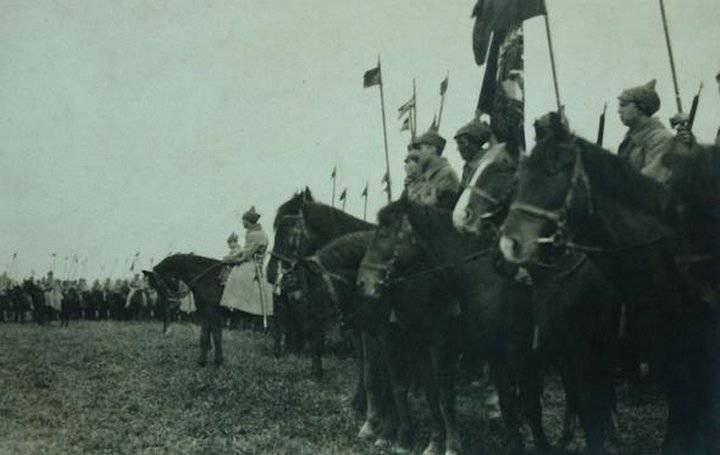
1-I Horse Army goes to the Polish Front
Defeat near Warsaw
Meanwhile, the Polish command (with the participation of the French General Weygun) was desperately trying to stop the further advance of the Red Army. Under the leadership of French General Maxim Weygun, who actually led the Polish army, a plan of military operations was developed and August 6 was approved. The main idea of the plan was as follows: 1) chained Soviet troops in the south, covering Lviv and the oil basin in Galicia; 2) in the north, not to allow Red Army units to bypass along the German border and weaken the blow of the Soviet troops by defending bridgeheads on the eastern bank of the Vistula; 3) in the center - quickly form a strike force on the lower Vistula, and stop and break them at the flank and rear of the troops of the Soviet Western Front advancing on the Warsaw area.
Thus, the Polish command decided to forge the Soviet troops with the stubborn defense of Warsaw and at the same time prepare a strike south of Lublin. In accordance with this plan, the Polish troops were divided into three fronts: Northern, Middle and Southern. Northern front of General Józef Haller (Haller). It consisted of three armies: the 5-I Army of General V. Sikorsky was given the task of keeping the defense on the Narew; 1 Army General F. Latinik - to defend itself on the approaches to Warsaw; 2-I army of General B. Roy - on the left bank of the Vistula. The middle (Central) front of General Edward Rydz-Smigly composed a strike group. The main strike force of the Middle Front was the 4-I army of General L. Skersky, located in the area of Dembin - Lublin. From the Lublin area, Chelm should have attacked the 3-I army of General Z. Zelinsky. The southern front of General Vatslav Ivashkevich as part of the 6-th army of General V. Engeevsky and Petliura units was supposed to cover Eastern Galicia with Lvov.
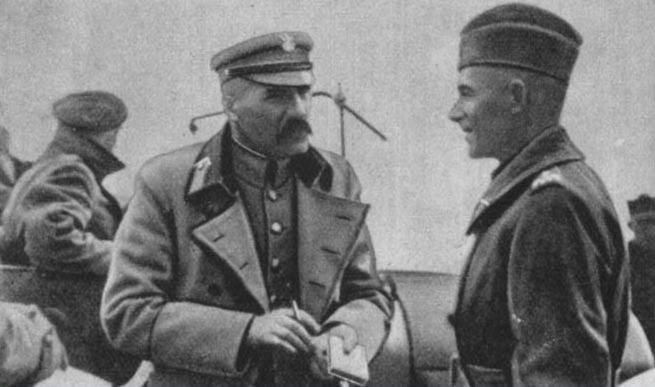
Jozef Pilsudski and Edward Rydz-Smigly at the head of the strike group. August 1920 of the year
According to the plan, out of 23 Polish divisions, twenty were to take part in the Warsaw operation. Most of the cavalry was concentrated in the same sector. The remaining 3 divisions, etc. "Ukrainian army" defended in the Lvov direction. The total number of Polish troops differs in all sources, it is reported about 100-200 thousand. army with 108 heavy and 526 light guns, 70 tanks... The Polish command added to the divisions. Polish troops relied on the heavily fortified Warsaw region. The approaches to the Polish capital from the east were a serious fortified area with two defense lines reinforced with barbed wire. In the fortified area, in addition to field troops with their artillery, there were 43 stationary batteries. All this artillery was controlled centrally. In addition, the fortified area had an extensive network of railways on which armored trains ply. At the same time, the fighting spirit of the Polish army increased significantly, the Poles defended their lands. A powerful propaganda campaign mobilized the Poles. A massive call for volunteers began (by mid-August there were already about 70 thousand people).
By the middle of August, the main forces of the Western Front in the Warsaw direction reached the line Pultusk - Radzymin - Siedlec. The advanced units of the Soviet army went to Warsaw. Part of the forces began to bypass the Polish capital from the north-west. It seemed that victory was near. However, it was an appearance. The armies of the Western Front were already exhausted by previous battles and marches, suffered serious losses. There was no heavy artillery; Warsaw fortification had to be stormed only with battered field artillery, which had lost part of the barrels during previous battles and had a minimum amount of ammunition. The rears were stretched, lagging behind the armies on 200-450 km, the troops needed literally everything. An important role was played by the mistakes of the army and front command. Tukhachevsky did not justify the hopes placed on him. The attack on Warsaw began extremely unorganized. In addition, the Poles intercepted telegrams of the Soviet command, which allowed them to react in a timely manner to the movements of the Red Army.
August 14 launched the attack of Vladislav Sikorsky's 5 Army. Polish troops hit the stretched front of the Western Front at the junction of the 3 and 15 armies, and broke through it. On the night of August 15, two reserve Polish divisions took Radzymin. On August 15, the cavalry of the 5 of the Polish Army captured Ciechanow, located in the rear of the 4 of the Soviet army, where the army headquarters were located. The army headquarters fled in disarray, the radio station was destroyed. As a result, the communication of the headquarters was lost, both with its units and with the front headquarters. The entire right flank of the Western Front was left without control.
On the same days, units of the Red Army tried unsuccessfully to break through to Warsaw. The fire of the Polish artillery, armored trains and armored vehicles that cruised the railways and highways held at the fortified positions, mercilessly pressed every attempt of our tired and weakened divisions to move forward.
16 August Marshal Pilsudski launched a planned counter-offensive. The Polish command concentrated against the weak Mozyr group a powerful strike force. With more than a double margin - 47,5 thousand soldiers against 21 thousand, Polish troops literally swept the southern wing of Sollogub's 16 army. The Poles were rapidly moving to the northeast. There was a threat of violation of all communications of the Western Front and the encirclement of the troops attacking Warsaw.
17 August Soviet troops began to retreat to the east. On the night of August 18, Tukhachevsky ordered to stop all offensive actions, which in a number of sectors continued to make front formations and “break away from the enemy”. The Soviet command was still trying to rectify the situation by forming a shock rear group in the area of Brest-Litovsk. However, due to disorder in the rear and the railway service, this was not possible. Commander-in-Chief Kamenev, on August 14, transferred 12 and 1 Cavalry armies from the South-Western Front to the Western Front. However, due to irregularities in the work of the administrative apparatus, the 1-th Cavalry Army brought out only 20 August from Lviv. This delayed help could no longer rectify the catastrophe in the Warsaw area.
18 August Polish troops launched a counteroffensive with all available forces. 19 August Poles knocked out a weak Mozyr group from Brest. The command of the 16-th Soviet army simply did not have time to regroup their forces and cling to any frontier. The enemy was ahead of the Soviet troops at the exit at any suitable defense line, and the race continued. 23 August Soviet troops left Bialystok. Fully collapsed right flank of the front. The 4 Army, the 3 Cavalry Corps of Guy, and two divisions from the 15 Army (about 40 thousand people) were driven into German territory and interned there. Only a small part of the 4 Army escaped.
1-I Cavalry army struck in the direction of Zamoć and Hrubieszowa, planning to go to Lublin, to the rear of the advancing Polish strike force. Polish commanders threw their equestrian reserves against the red cavalry. The cavalry army could not overthrow the Poles. She was exhausted by the previous battles, her number more than halved. The Soviet cavalry left the supply bases on the right bank of the Western Bug, and during the 5-day raid was forced to overcome a wooded and swampy area, which became almost impassable during continuous rain. In essence, Budyonny’s army started fighting only on August 25, when everything was already decided in the Warsaw area. Extremely tired and having a minimum amount of ammunition, Soviet units could not break through the Polish defense.
The Polish command in the Zamoi area had already managed to regroup, and the Soviet cavalry was met not only by units of the 3 Polish army, but reserves, the 10 and 13 I infantry, 1 I Ukrainian and Cossack divisions approached. The Poles launched an offensive from the south and cut off the 2 Cavalry Army from its rear. They began an offensive in the north. There was a threat of encirclement. The Budyonny army day and night of August 1 led heavy battles with the Polish units surrounding it. She struggled out of the emerging boiler. Thus, the troops of the South-Western Front could not change the course of the battle, they themselves had to withdraw and go on the defensive.
By August 25, the divisions of the Soviet 15, 3, and 16 armies left the direct strikes of the Polish forces and began to dig in at new positions on the Neman-Shchara-Svisloch line. Soviet troops suffered huge human and material losses. The exact losses are unknown, but according to some sources, 25 thousand people died during the Warsaw battle, 60 thousand were captured in Polish captivity (according to other data, prisoners were much more) and 40-45 thousand were interned by the Germans. A few more thousand people were reported missing.
Divisions suffered huge material losses. From the 15 Army, only the 1 Rifle Division withdrew in perfect order, retaining all the property. The 11 Division lost some of their artillery, and the 4 Division and 33 Division ended up in East Prussia, where they lost everything. The greatest casualties were in the 16 Army, which was the link between the front strike group and the left flank of the western front. After the retreat of the Mozyr group, the 16-I army suffered the most from the strike of the Pilsudski group. Of the 15 army brigades, only 4 survived militarily and organizationally. Most of the artillery of the army was lost. Under the Mflenchitsy, Polish cavalry completely destroyed the shock artillery group of the 16 Army (more than 1,6 thousand people were killed and captured, 37 guns were lost). Some divisions lost from 85 to 100% of all artillery. As a result of the retreat, the Western Front lost to 35% artillery. The 231 gun, the 1023 machine gun, several thousand horses, the 10 thousands of stockpiles, many cars and other military materials were lost.
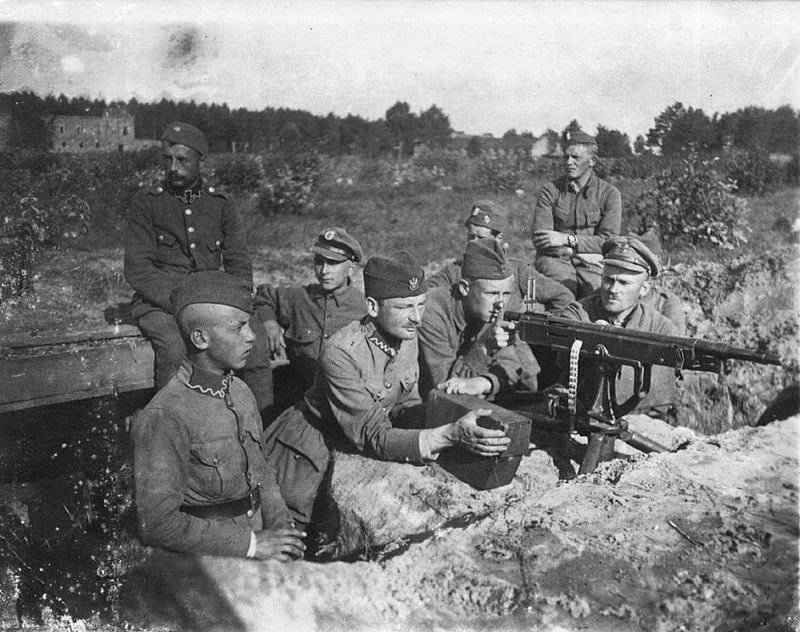
Polish soldiers in positions
Further fighting
The western front received considerable reinforcements from the rear areas. It was joined by soldiers returned by the Germans. The western front almost fully restored combat capability. At the beginning of 1 September, the front totaled 73 thousand people. By September 15, the divisional states planned to bring thousands of people to 6. In order to better organize the rear, we began a remaking of the railways on a broad gauge, also built bridges. By order of Kamenev, Tukhachevsky was preparing a new offensive. The offensive was planned to begin on September 12 on Wlodawa and Brest by the forces of the left flank of the front (4-I and 12-I armies).
The Polish troops also planned to attack, hoping to seize the designated territories. The attacks on Grodno and Volkovysk planned to bind the main forces of the Western Front, and by the forces of the 2 Army through the territory of Lithuania to break through to the rear of the Soviet troops, who were defending on the Neman. Intercepting Tukhachevsky's order to launch an offensive, the Poles hit first. 12 September they captured Kobrin, and then Kovel. The defense of the 12 Army was broken through, the management of its units was broken. The Poles began to develop an offensive between the flanks of the 4 and 12 armies. September 16 Polish troops occupied Lutsk, September 18 - Exactly, September September 19 - Pruzhany. The Soviet offensive was foiled, and the threat of encirclement of the southern grouping of the Western Front appeared. The 4, 12, and 14, the Soviet armies moved east.
20 September 1920 began a stubborn battle for Grodno. First, the Polish troops pressed the Red Army. But on September 22, the Soviet command pulled up reserves and restored the front. Meanwhile, the Polish army invaded Lithuania and entered the flank of the Western Front. September 25 Tukhachevsky ordered the withdrawal to the east. On the night of September 26, Polish troops occupied Grodno. The Polish command hoped to build on the success and defeat the Soviet troops in the Novogrudok area. However, the Poles did not have enough strength for a new breakthrough. The western front was able to gain a foothold at the new frontier. Further battles did not bring success to either the Polish or Soviet armies. Began peace negotiations.
Riga Treaty
October 12 1920 was signed a truce in Riga. 18 March 1921 was signed a peace treaty in Riga. Poland received significant territories with a predominance of the West Russian population (the Grodno province, the western part of the Volyn province and part of the territories of other provinces of the former Russian Empire).
Poland was freed from debts and other obligations of the Russian Empire. Moscow pledged to pay Warsaw 30 million in gold in compensation to the Polish part of the gold reserves of the Russian Empire. Soviet Russia also returned 300 locomotives to Poland, more than 8 thousand passenger and freight cars. The RSFSR and the Ukrainian SSR left in Poland rolling stock adapted for wide gauge - 255 locomotives, more than 9 thousand passenger and freight cars. In general, the total value of rolling stock returned or transferred to Poland, as well as other railway assets, railway stations, etc., was estimated at 18 million 245 thousand rubles in gold at 1913 prices of the year. It was a serious amount. In addition, Moscow agreed to hand over to Warsaw war trophies, all scientific and cultural values that the Polish state lost during the divisions.
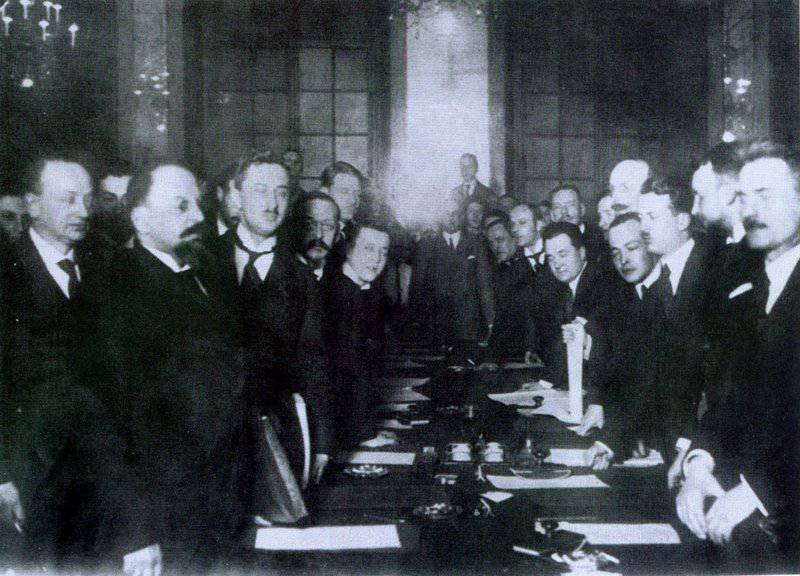
Signing of the Riga Peace Treaty in 1921
Results of the war
Thus ended the war forgotten in modern Russia, the initiator of which was Warsaw, although the Soviet government tried with all its might to avoid this war, not just offering peace to Poland and compromising its interests. The Pansky "elite" threw its people into war with Soviet Russia, seeking to seize not only the lands inhabited by the Poles, but also the regions that used to be part of the Polish-Lithuanian Commonwealth. Due to the ambitions of the Polish leadership, tens of thousands of people, both Russians (Great Russians, Little Russians and Belarusians), and Poles perished. Many civilians were victims of Polish terror. Only in the Polish concentration camps, about 80 thousand Red Army men died from starvation, disease, torture, bullying and executions.
On the Polish side, it was not a war of independence or a war with "insidious Bolsheviks", the Poles called it Polish-Russian. Not having time to be born, as the Second Rzeczpospolita immediately became the aggressor, having territorial claims to all its neighbors. The Polish leadership set itself the task of seizing as large territories as possible in the East. Even when the Poles were armed by the Germans, they dispersed the nationalist governments of Lithuania and Belarus, and at the end of 1918, they seized Galicia, fighting the Germans in Silesia and the Czechs in the Těšín region.
Moscow’s repeated appeals to Warsaw with proposals for peace were ignored. Poland did not want peace, she wanted a war of conquest. Having settled with the Ukrainian nationalists, the Poles attacked Soviet Russia. Pilsudsky brazenly declared: “My dream is to reach Moscow and write on the Kremlin wall:“ To speak Russian is forbidden. ”
However, this plan was only partially implemented. The first blow of the Polish aggressor was repelled, the Soviet troops moved on Warsaw, the aggressor was put to shame. But in order to end the war with victory, there was no strength. Soviet Russia was exhausted, and Poland was supported by the great powers: France, the United States and Britain. Thanks to the “Miracle on the Vistula”, the second part of the Polish-Lithuanian Commonwealth included a part of Lithuania and West Russian lands (Western Belorussia and Western Little Russia). This victory allowed Poland to include parts of Germany and Czechoslovakia in the west.
Part 1. Poland "from sea to sea." The death of the Second Polish-Lithuanian Commonwealth - a lesson for modern Poland.
To be continued ...
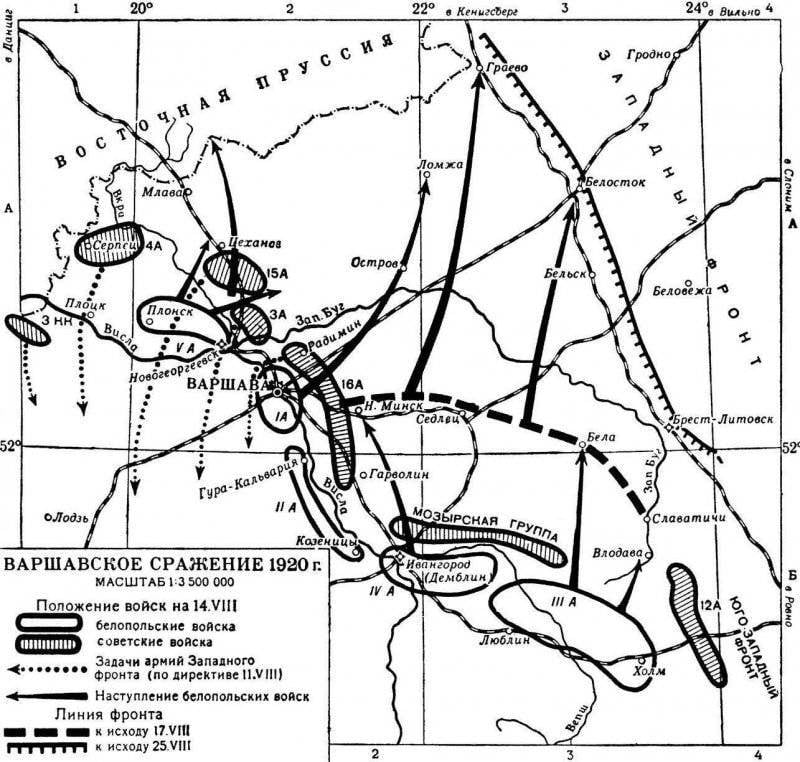
Information